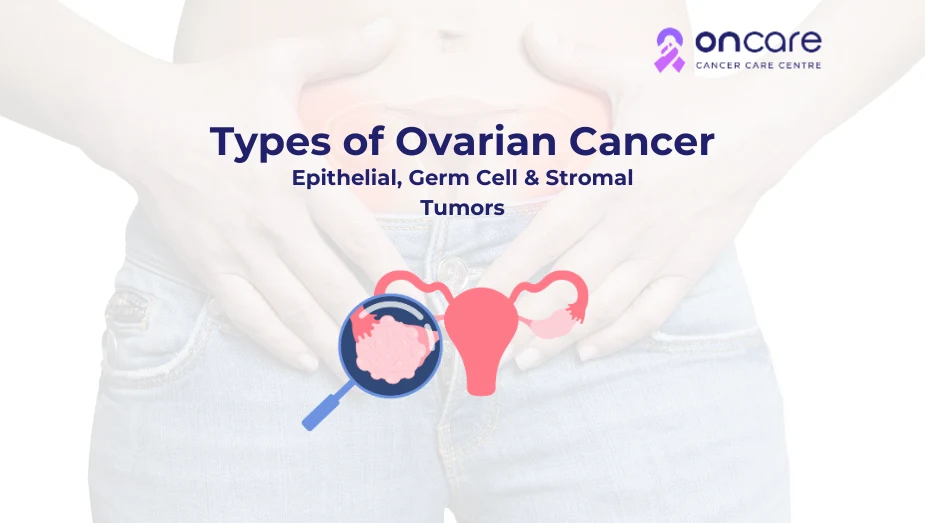Table of Contents
Types of Ovarian Cancer: Epithelial, Germ Cell & Stromal Tumors

Ovarian cancer is one of the most complex cancers affecting women. Understanding different types of ovarian cancer is vital for early diagnosis, accurate diagnosis, and effective cancer treatment. The three main ovarian cancers are epithelial cancer, germ cell tumors, and stromal tumors. They often arise from different parts of the ovaries, and they show various characteristics and treatment outcomes.
In this article, we’ll discuss more about the key characteristics of these cancers, their symptoms, and their treatments.
Epithelial Ovarian cancer
This is the most common type of ovarian cancer and this type of ovarian cancer generally develops in the epithelial tissue, a thin lining that generally covers the outside of the ovary. This type of cancer may also form in the lining of a fallopian tube. It can also develop in the peritoneum which is a type of tissue that covers the abdominal organs.
Subtypes
Here are some common types of epithelial ovarian cancer.
These may include:
- High-grade serous carcinoma
- Low- grade serous carcinoma
- Endometrioid carcinoma
- Mucinous carcinoma
- Clear cell carcinoma
Key characteristics
These types of cancers are most common in women who are above the age of 40 and 50. Epithelial cancers are often diagnosed in the advanced stage due to some subtle and non-specific symptoms. This type of cancer can often spread rapidly into the abdominal cavity.
Symptoms
Here are some of the symptoms of ovarian cancer.
These may include:
- Abdominal pain
- Feeling full quickly after eating
- Nausea and vomiting
- Bloating
- Pelvic pain
- Urgent needs to urinate (frequent urination)
- Vaginal bleeding
Treatment
Depending on the type of cancer, your medical team might suggest you get these types of treatments after performing the surgery.
- Chemotherapy: This treatment is often used to destroy cancer cells. These treatments also include platinum compounds such as carboplatin and paclitaxel, and or docetaxel.
- Intraperitoneal chemotherapy: These treatments are often used to treat stage 3 ovarian cancer by injecting medicine such as cisplatin and paclitaxel directly into the abdominal cavity through a surgically placed catheter, which is a thin and hollow tube.
- Targeted therapy: These treatments use medicines such as bevacizumab to stop cancer cells from growing and multiplying.
- Radiation therapy: These treatments often destroy cancer cells with high-energy X-ray beams.
Germ cell ovarian tumours
Ovarian germ cell tumors develop in the reproductive cells, such as germ cells, inside the ovaries. These ovarian germ cell tumors usually form in just one or sometimes both ovaries. Studies have shown that these tumors are less common and account for more than 5% of ovarian cancers. These cancers are mostly developed in teenagers and young women.
Subtypes
The most common types of ovarian germ cell tumors are:
- Mature teratoma
- Immature teratoma
- Dysgerminoma
- Endodermal sinus tumors (Yolk sac tumors)
Key characteristics
It may be difficult to spot signs of ovarian germ cells tumors early on. Meanwhile, these malignant germ cell ovarian cancers are fast-growing but usually confined to one ovary. In most cases, these cancers are discovered in their early stages. Studies show a high cure rate even in its advanced stages.
While benign tumors may not cause symptoms unless they are large. Approximately 95% of ovarian cells are benign (mature teratomas), only 2 to 3%of ovarian cancers are germ cell tumors.
Synonyms
There are some symptoms to watch out for:
These may include:
- Abdominal pain
- Discomfort or tenderness
- Bloated belly
- Changes in bowel habits
- Loss of appetite
- Irregular vaginal bleeding
Treatment
The treatment commonly depends on the type of the tumor and stage of the cancer. Common treatments may include:
- Surgery: Your medical team might suggest an oophorectomy to remove one or both of the ovaries or fallopian tubes. When the cancer has spread beyond the ovaries and fallopian tubes, then you may need to undergo hysterectomy to remove the uterus and cervix.
- Chemotherapy: During chemotherapy treatments, your doctor might give medicines through the veins, usually through an infusion. Chemotherapy drugs are used to destroy cancerous cells and help to stop them multiplying. Your doctor might recommend chemotherapy treatments for several weeks and months.
Stromal ovarian tumors
The ovarian stromal tumors develop in the ovaries' structural connective tissue that helps to produce some female hormones such as estrogen and progesterone. Stromal cells are one of the three most common types to be affected by ovarian cancer. These types of cancer account for approximately 1% of ovarian cancer.
Subtypes
Here are some common subtypes of stromal ovarian tumors.
- Granulosa cell tumors
- Sertoli- Leydig cell tumors
- Thecoma and fibroma
Key characteristics
Studies suggest that these types of tumors account for about 5 to 7% of ovarian cancers in women. It might secrete hormones, which further leads to early signs such as irregular bleeding or early puberty in teenagers. These types of cancer are often diagnosed early due to some hormonal symptoms.
Synonyms
Here are some of the common symptoms:
- Abnormal vaginal bleeding
- Experiencing breast tenderness
- Early puberty in young girls
- Pelvic mass or pain
Treatments
- Surgery: In most cases, these cancers are identified in the early stages. One of the most recommended treatments used for this stage is surgery. It used to remove the tumor and ovary. Any other treatments are needed after this.
- Chemotherapy: Apart from surgery, doctors also perform chemotherapy in patients, which helps to destroy cancer cells.
- Hormone therapy: This is another treatment option used for patients who can’t handle chemotherapy.
- Radiation therapy: In some rare cases, doctors use radiation therapy on patients to treat tumors.
Why does understanding these types matter?
Recognising each type of ovarian cancer is significant in a treatment and healing journey. Each type of cancer behaves differently to the medicine and treatment options. Their unique response to the medication and treatment will affect the healing journey and its overall duration of recovery or remission in a patient.
Choosing a correct cancer diagnosis helps in:
- Select the best treatment strategy
- Predict the best treatment outcomes and its survival
- Plan for fertility preservation in young women
Consult Today
Understanding the various types of ovarian cancer, which may include epithelial, germ cell, and stromal tumors, is considered crucial in managing these diseases. While epithelial tumors are most common and aggressive, germ cell and stromal types often present early and are more treatable. Performing regular checkups, paying close attention to any unusual symptoms, and early medical intervention can make a significant difference in the cancer healing journey.
At Oncare, we offer premium quality cancer treatments including advanced cancer surgeries at affordable price ranges with an experienced cancer specialist consultation.
If you or any loved ones of yours are diagnosed with cancer, then visit Oncare Cancer Center and book an appointment with our cancer specialist today. Get an estimated cost of your cancer treatments today!
Frequently Asked Questions
Ovarian cancer is classified based on the type of cells where it develops. Here are some of the types of ovarian cancer.
These may include:
- Epithelial Ovarian cancer
- Germ cell tumors
- Stromal cell tumors
Ovarian cancer symptoms may include:
- Pelvic or abdominal pain
- Discomfort
- Bloating
- Vaginal discharge
- Unusual vaginal bleeding
- Bowel changes
- Diarrhea
- Constipation
- An increase in the size of abdomen
- Peeing more often (frequent urination)
The exact cause of ovarian cancer is not known yet. Some people have a higher risk of developing this condition. There are some risk factors that may increase the risk of developing this cancer.
- Over the age of 60
- Obesity
- Family history of ovarian cancer
- Never being pregnant
- Endometriasis
Here are some common ovarian treatments, including:
- Surgery
- Chemotherapy
- Targeted therapy
- Hormone therapy
- Radiation therapy

